Love duck but find the cooking process too time-consuming for weekdays? Prepare to have your mind changed by this Duck Chow Mein. In less than 30 minutes you can feast on crispy, yet succulent duck breast served with stir-fried noodles and veggies coated in the tastiest 5-ingredient hoisin stir-fry sauce.
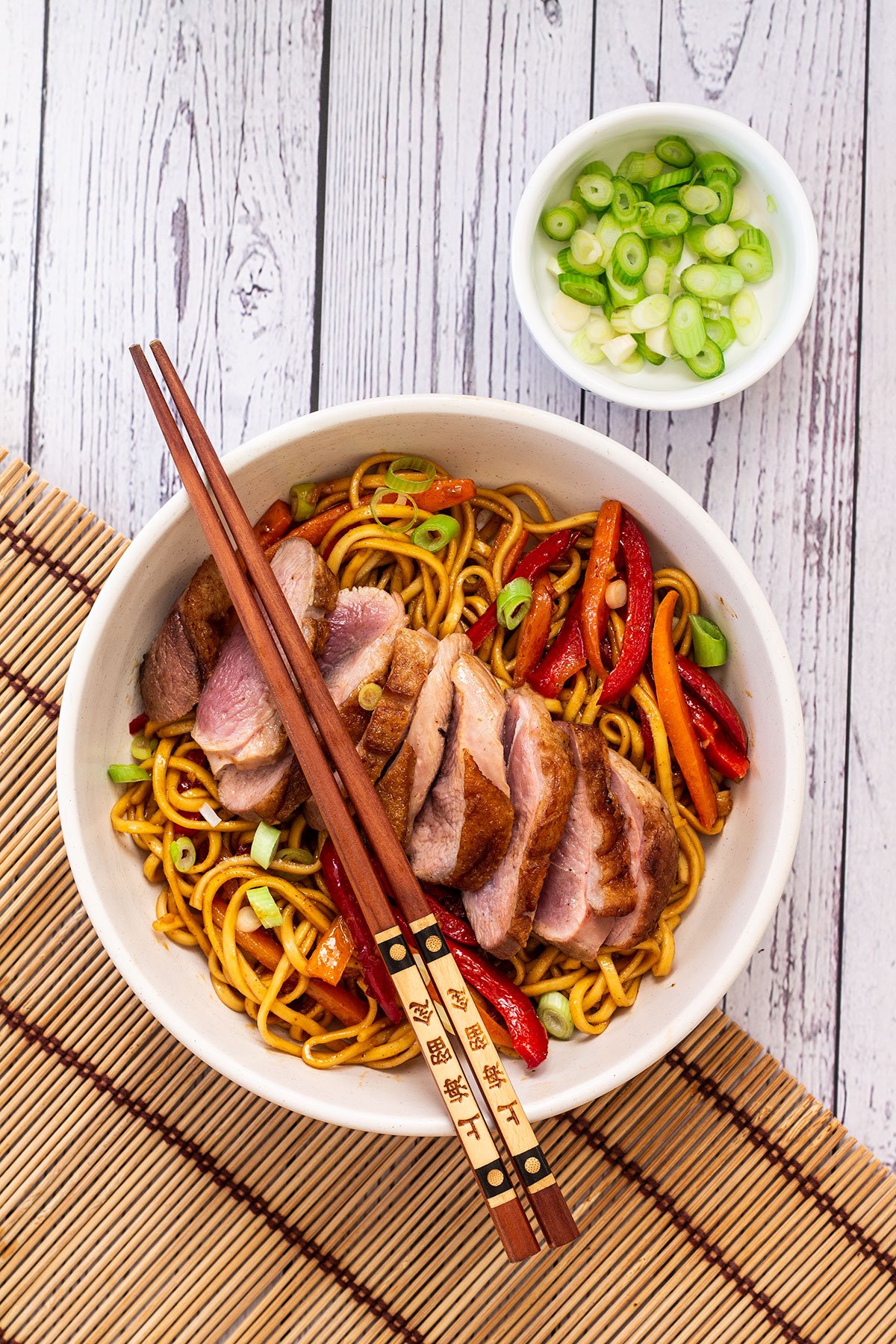
Noodle stir-fry recipes are flavourful, nourishing, super versatile and easy to throw together. If this duck noodle stir-fry appeals, you might also want to try my Fakeaway Chicken Chow Mein, Singapore Style Chow Mein, Plain Chow Mein, and Salmon Teriyaki Noodles.
The post contains additional information and helpful tips to ensure the recipe turns out great the first time. Please use the link above to jump to the recipe card at the end if you are in a hurry!
Jump to:
4 reasons why you'll love this recipe:
- Easy and speedy. On the table in less than 30 minutes.
- Shows you how to cook tender and juicy duck breast with perfectly crispy skin.
- A wholesome meal with nourishing veggies tossed in the tastiest homemade 5-ingredient hoisin stir fry sauce
- Adaptable with lots of ways to tweak it to make it your own
🛒 Key ingredients and possible alternatives
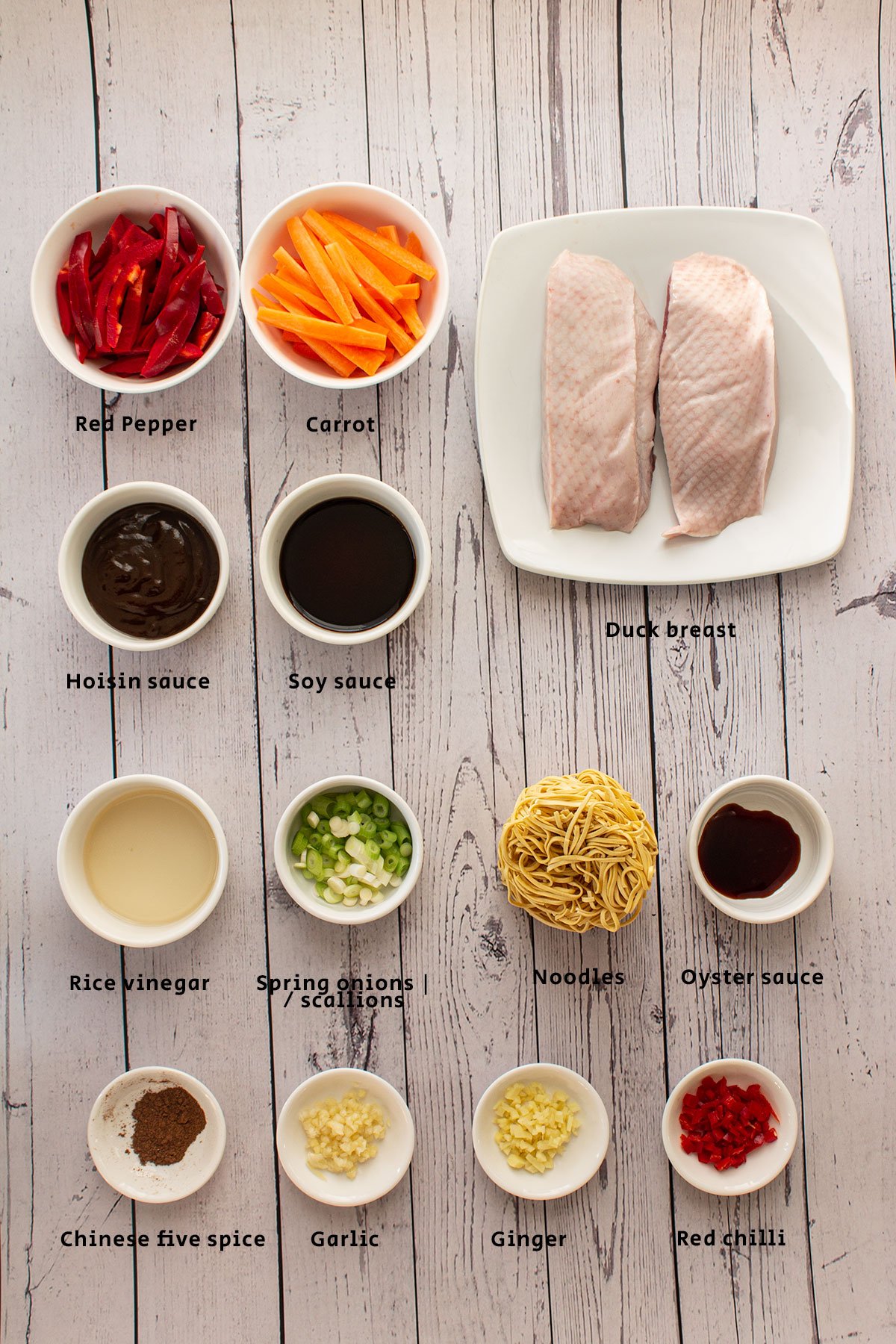
- 5-ingredient hoisin stir fry sauce: Made with regular or light soy sauce, hoisin sauce, rice vinegar, oyster sauce, and a small amount of Chinese five spice.
- Egg noodles: Medium egg noodles are recommended. You can use dried noodles or pre-cooked ones.
- Duck breast - I buy duck breast portions for this recipe, but you use full-sized duck breasts. The duck is sliced after it has been cooked so either option is fine.
- Ginger, red chilli, and garlic: Add additional freshness, umami flavour and heat to the stir-fry. Make sure you use fresh garlic and ginger.
- Veggies: Carrot sticks and red pepper are often my veggies of choice because they are easy to stir-fry and have a fresh sweetness that contrasts with the fatty savouriness of the duck.
- Spring onions/scallions: These are added when the stir-fry is served to provide a little crunch and tangy fresh flavour.
Substitutions
Note that the recipe has not been tested with the below substitutions and variations, so the results cannot be guaranteed.
- Rice vinegar: Substitute with apple cider vinegar.
- Egg noodles: Other types of noodles like ramen, udon and soba will also work. For a gluten-free option use gluten-free noodles or rice noodles.
- Red chilli: Can be substituted with chilli flakes.
Variations:
- Switch up the veggies: try asparagus, broccoli florets, beans, bean sprouts, pak choi, cabbage, courgette/zucchini or whatever else you fancy or have available.
- Use shredded cooked duck instead of freshly cooked duck breast. It's a great way to enjoy leftover roast duck.
- Vegetarian/vegan alternative with crispy fried tofu instead of duck. You'll also need to omit the oyster sauce or use vegan oyster sauce.
- Serve with rice instead of noodles.
🧑🍳 Recipe steps
Step 1: Mix the hoisin sauce, soy sauce, oyster sauce, rice vinegar and Chinese five-spice in a small bowl and set aside.
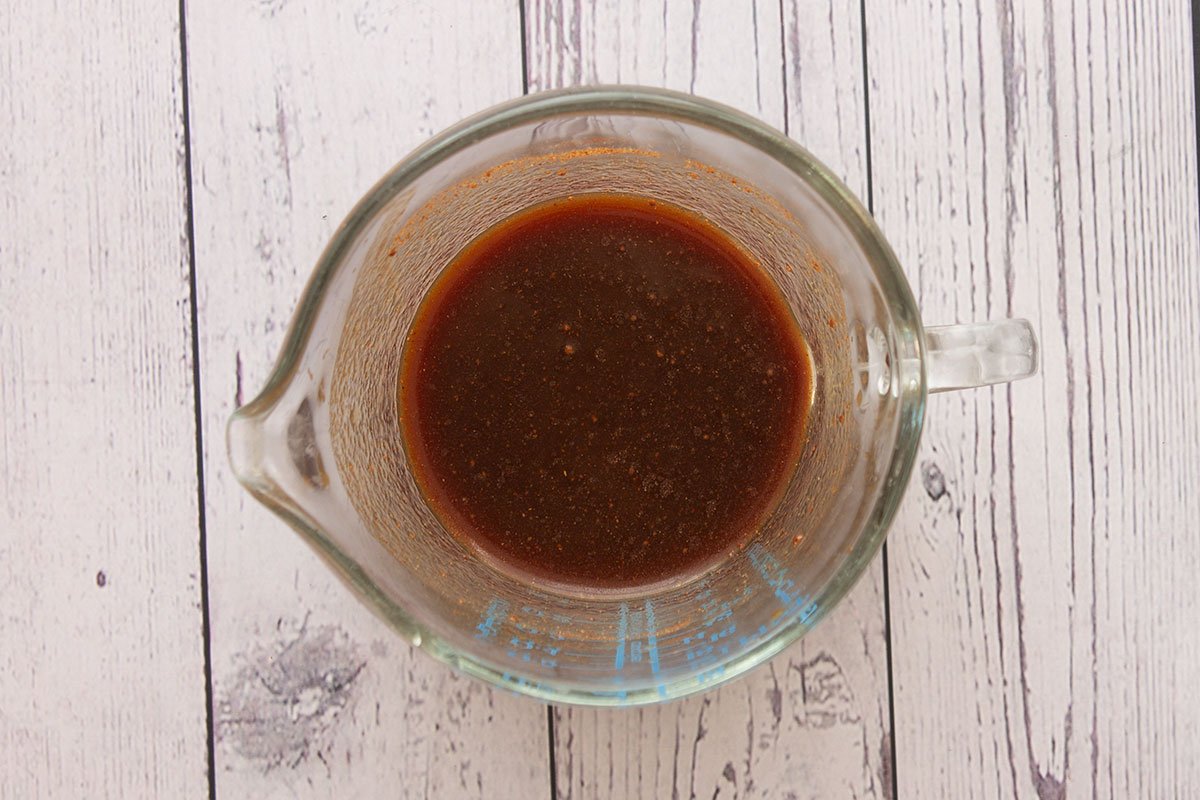
Step 2: Cook the noodles according to packet instructions. Run them under cold water when you drain them to prevent them from sticking together and set them aside.

Tips for cooking the noodles
- Cook the noodles ahead. Things move very quickly once you start stir-frying.
- Don't salt the water like you would for pasta. The hoisin stir-fry sauce will provide the flavour you need.
- Run the noodles under cold water after you drain them to prevent them from sticking.
- Cook the noodles until they are still a little hard. They will cook further when you add them to the wok.
Step 3: Score the skin in a diamond pattern. Be careful not to cut into the flesh. Sprinkle with salt and set aside.
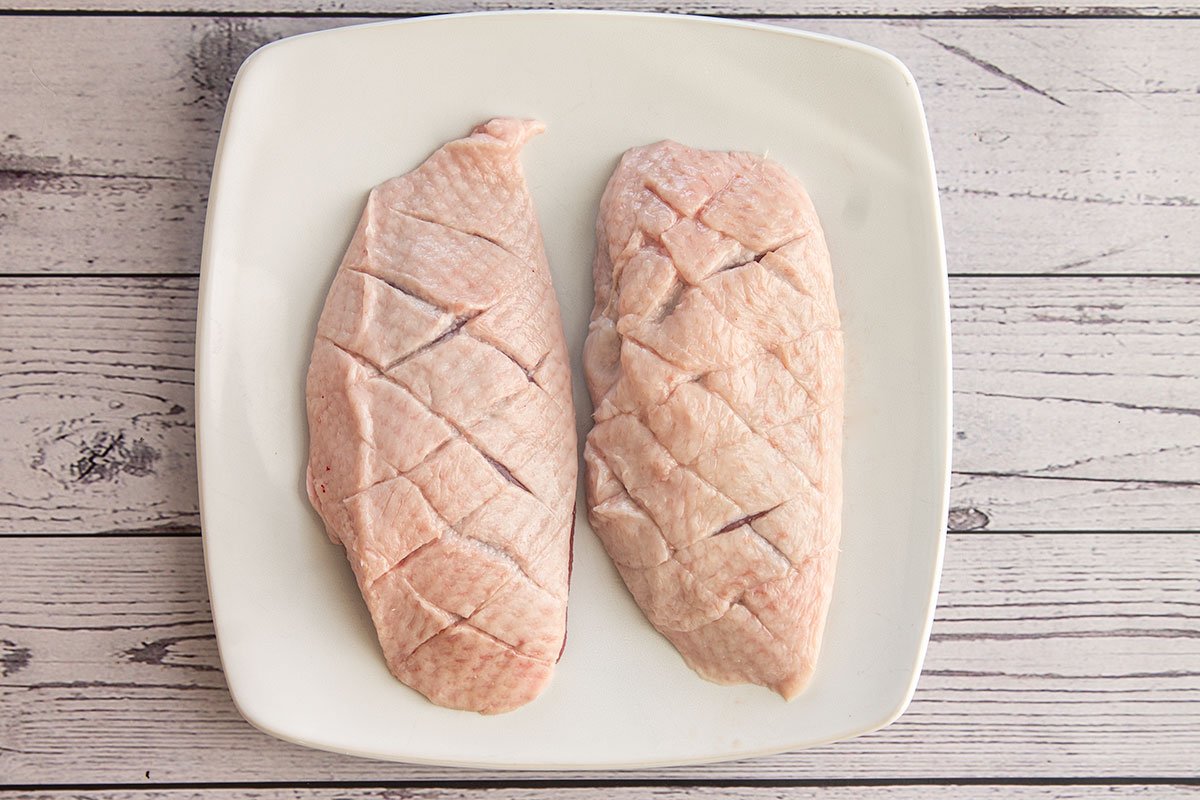
Step 4: Place a wok or large frying pan on a high heat and add the duck breasts with the skin-side facing down and fry for approximately 5 minutes until the skin is brown and crisp. Then turn the duck breast over and fry for 3-4 minutes until the bottom is brown. Use tongs to cook the sides of the duck breast then remove from the pan and place on a board to rest while you cook the stir fry.
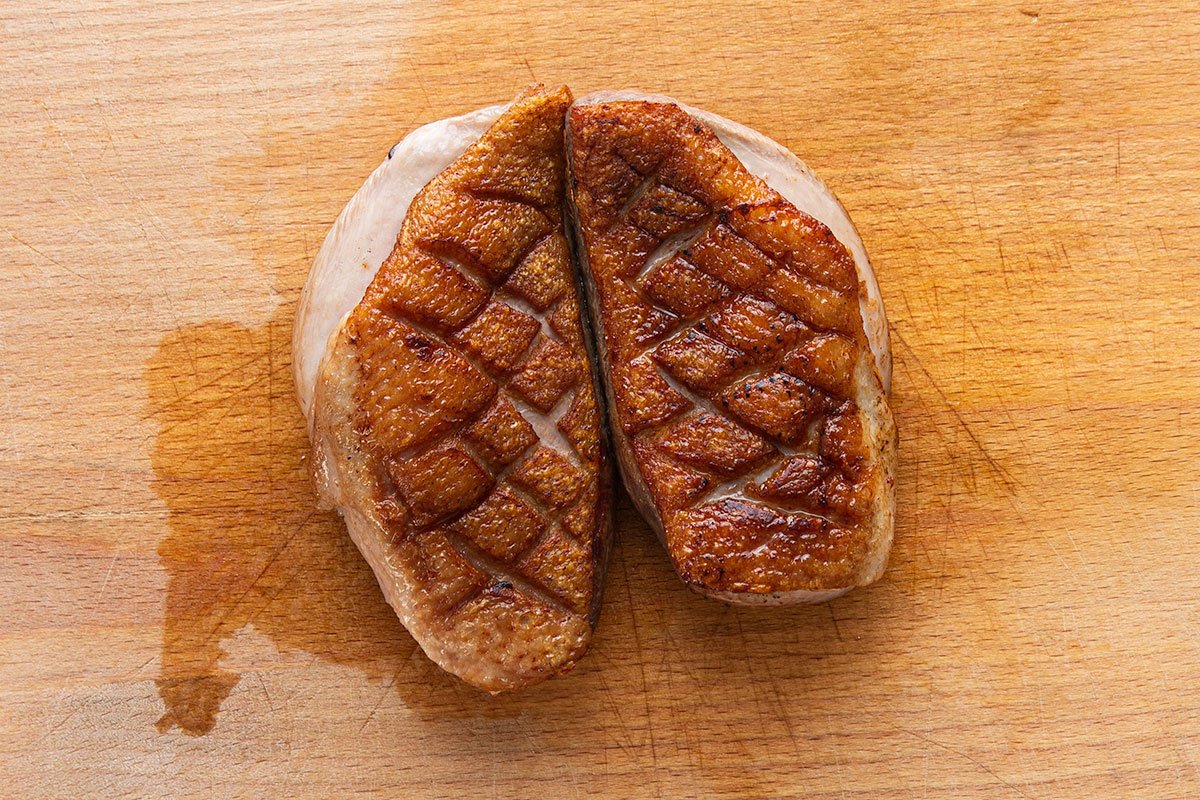
Step 5: Fry the ginger and chilli for 1-2 minutes. Then add the carrots and red pepper, and fry for a few minutes until they are tender. Add the garlic and cook for one minute until fragrant and add the cooked noodles and toss with the veggies until they are hot.
Pour on the sauce and cook for a few minutes until it reduces a little. Remove the pan from the heat and divide the stir-fried noodles and veggies into bowls. Cut the duck breast diagonally into slices and place it on top of each bowl and top with spring onions/scallions.
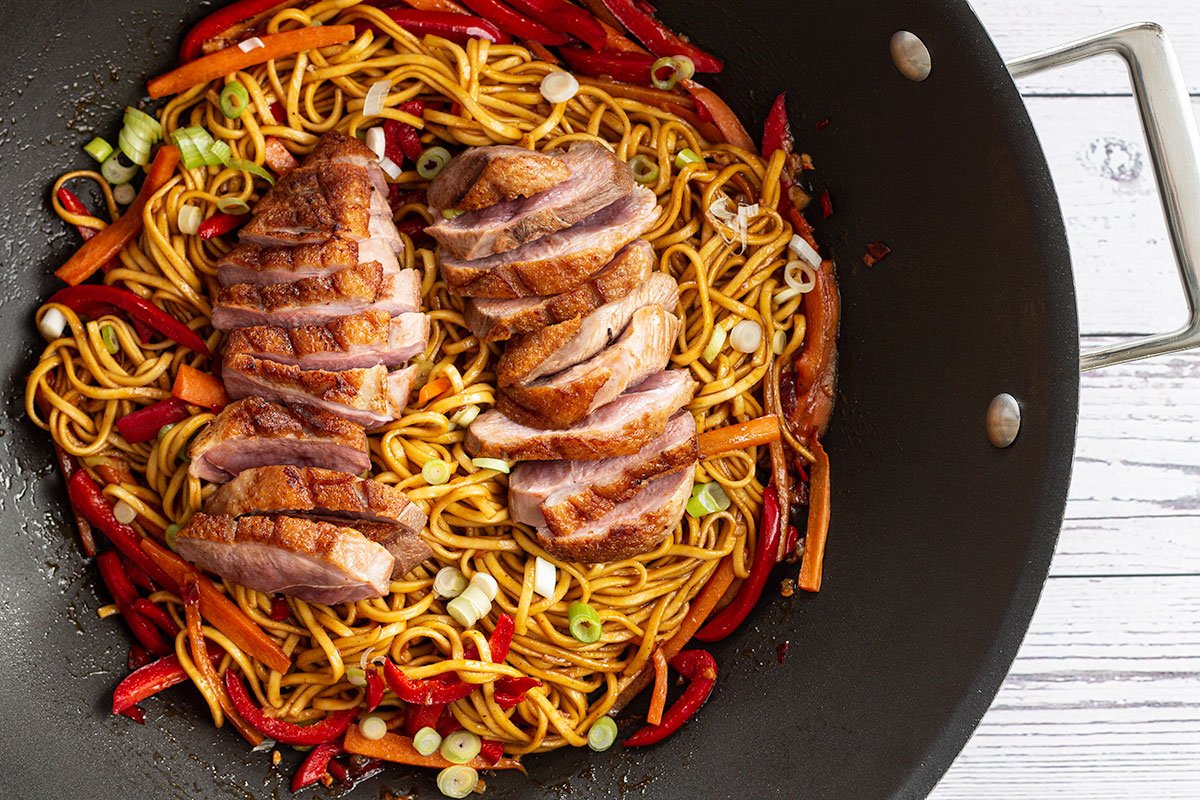
Serving suggestions
With protein-rich duck, noodles and lots of fresh veggies duck chow mein is certainly a satisfying standalone meal. Some spring rolls or a few prawn crackers on the side will go nicely. Or if you're feeding a crowd you might like to serve it alongside some other Asian dishes like Sweet and Sour Hong Kong Style Chicken, Chilli Honey Chicken or Crispy Shredded Beef with Chilli.
🔪 Tools and Equipment
- Sharp knife - for scoring the duck breast skin and prepping the veggies. Unless you have sharpened your knife very recently, I strongly advise sharpening it before you start because it makes scoring the duck breasts much easier.
- Large pan or wok - a wok is the best type of pan for stir-fries because its large sides enable you to toss the ingredients together quickly at a high heat. You can also use a large frying pan instead.
- Saucepan - for cooking the noodles.
- Tongs - are a very helpful tool for frying the duck breasts on a high heat safely and are also useful for serving the noodles.
Expert Tips
- Prep your ingredients before you begin - make sure the veggies are chopped, the noodles are cooked and the sauce is made before you begin the stir-frying process. Things will move really quickly once you start stir-frying and there will not be time to prep as you go.
- Score the duck breast - do not skip this, it's an essential step if you want crispy skin because it enables the fat to render during the cooking process. Try to avoid cutting into the meat when you do this, you want the flesh to retain its moisture and be delicious and succulent when you bite into it.
- Cook the duck breast on a high heat - make sure your pan is red hot before you add the duck breast. You can test this by adding a tiny drop of water, if it sizzles and evaporates immediately you are good to go. Otherwise, you will need to get the pan hotter before you cook the duck breast.
- Let the duck breast rest - this allows the temperature to regulate and the juices to be reabsorbed back into the meat. If you slice the duck breast too soon you will lose these juices and the duck breast won't be as moist and delicious. Duck breast should be rested for 10 minutes. If you set it aside after cooking it should be sufficiently rested by the time you come to serve the stir fry.
🙋 FAQs
Duck is a great source of protein and iron. It is higher in saturated fat than other leaner meats so it's best eaten in moderation, but it can be a valuable part of a balanced and healthy diet.
Stir-fried duck noodles taste best when served immediately. The skin will lose its crispiness if you leave it hanging around. You can store the leftovers in the fridge for up to 2 days and reheat them on the stove or in the microwave. This dish is not suitable for freezing.
It's a definite yes from me, because it's delightfully crispy and flavourful when cooked well. It is the fattiest part of the duck breast. You might want to remove it if you are trying to reduce your fat intake or if fatty food isn't appealing to you.
Ensure your ingredients are dry before adding them to the hot pan or wok. Cook them in small batches over high heat, allowing excess moisture to evaporate quickly. Finally, refrain from overcrowding the pan, as this can cause the ingredients to steam rather than sear, resulting in a soggy texture.
You can, and the duck stir-fry would turn out okay, but these noodles aren't the best match for the flavours and texture in the stir-fry. Ramen, udon, or soba noodles are better alternatives.
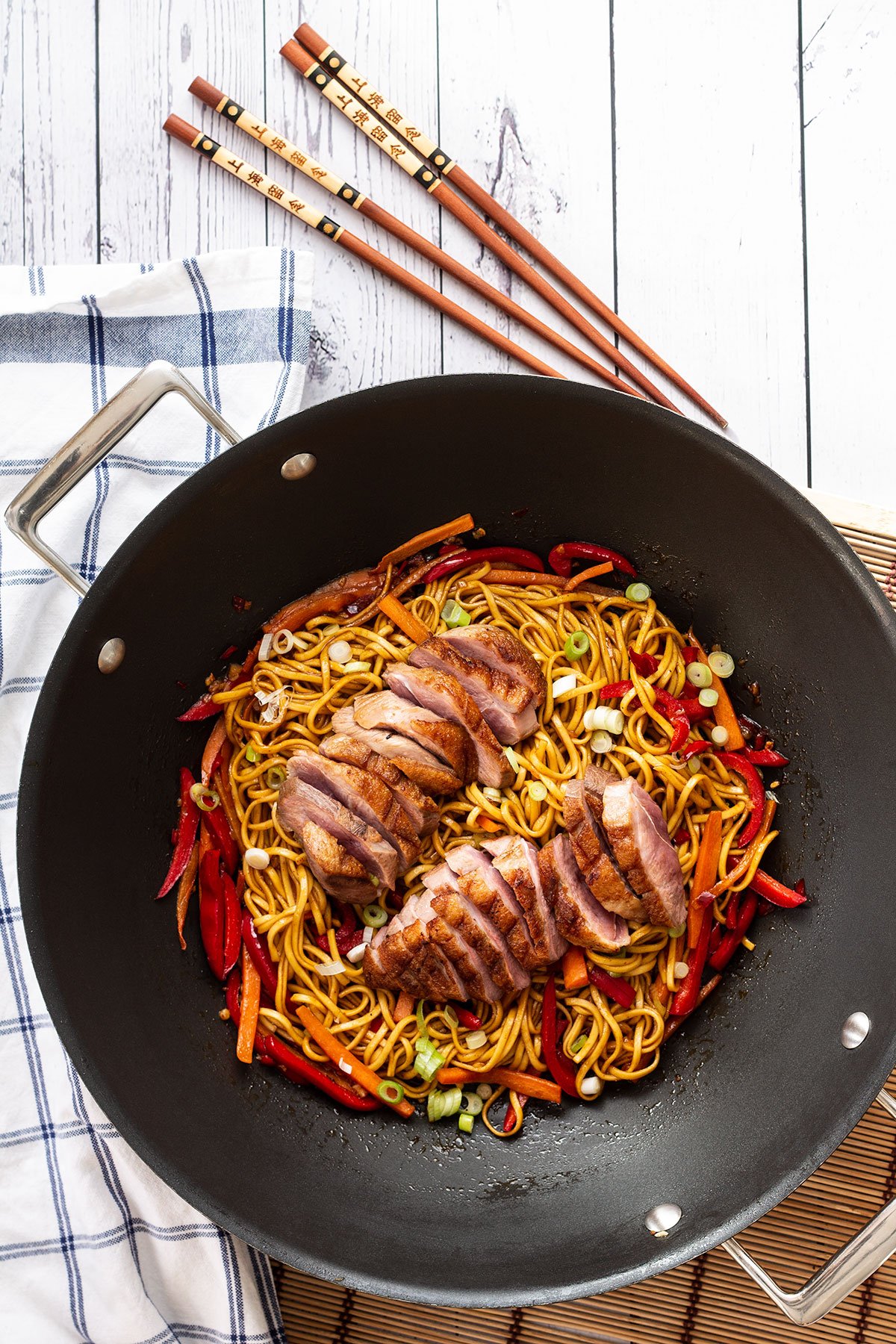
📖 Recipe
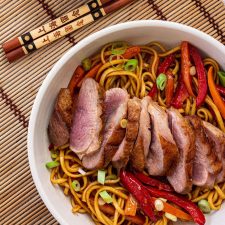
Duck Stir Fry With Noodles and Hoisin Sauce
Ingredients
Sauce ingredients:
- 2 tbsp soy sauce (Note 1)
- 3 tbsp hoisin sauce
- 3 tbsp rice vinegar or apple cider vinegar
- 1 tbsp oyster sauce
- ½ tsp Chinese five-spice
Stir fry duck:
- 2 portions of medium egg noodles (Note 2)
- 250 g (9 oz) duck breast portions (Note 3)
- Sea or kosher salt for prepping the duck breast
- 2 tsp ginger grated
- 1 red chilli finely chopped (Note 4)
- 1 medium carrot cut to match sticks (Note 5)
- 1 red pepper cut vertically into 0.5 cm or quarter-inch sticks
- 2 cloves garlic crushed
To serve:
- 2 spring onions/scallions thinly sliced
Instructions
- Make the sauce by mixing the sauce ingredients in a small jug or bowl and set aside.
- Bring a saucepan of water to boil and cook the noodles according to packet instructions.
- Meanwhile, remove any excess moisture from the duck-breast fillets with kitchen paper and score the skin in a diamond cross pattern with a sharp knife. Be careful not to cut into the flesh.
- Sprinkle the duck breast fillets with salt.
- Place your wok on a high heat and fry the scored duck fillets skin side down, for 5 minutes.
- It's likely you will need to drain the noodles while the duck fillets are frying. Strain them with a colander and run cold water over them to prevent them from sticking and set aside.
- Turn the duck fillets over and fry for another 3-4 minutes until the bottoms are brown. (note 6)
- Use tongs to cook the sides of the duck breast fillets and then remove from the wok and set them aside on a wooden board or plate. (note 7)
- Add the ginger, chilli, carrot, and red pepper to the wok and fry on a high heat for a few minutes until they are tender. Then reduce the heat to medium and add the garlic.
- Add the cooked noodles to the wok and toss at a high heat until they are hot.
- Then add the sauce, cook for a few minutes until it is incorporated and reduced a little.
- Remove the pan from the heat and place the cooked noodles and veggies on plates or in bowls.
- Slice the cooked duck breasts diagonally with a sharp knife, place on top of the noodles, top with spring onions/scallions and serve.
Notes
- Soy sauce: Use regular or light soy sauce. Dark will be too rich.
- Egg noodles: Medium egg noodles are recommended. You can use dried noodles or pre-cooked ones. Allow approx 65g or 2.5oz of dried egg noodles per person. Other types of noodles like ramen, udon and soba will also work. For a gluten-free option use gluten-free noodles or rice noodles.
- Duck: I buy duck breast portions for this recipe, but you can use full-sized duck breasts. The duck is sliced after it has been cooked, so either is fine.
- Red chilli: Can be substituted with chilli flakes.
- Veggies: Feel free to switch things up. Try asparagus, broccoli florets, beans, bean sprouts, pak choi, cabbage, courgette/zucchini or whatever else you fancy or have available.
- Doneness: The timings in the recipe will result in medium-rare duck breast. You will need to cook it for a little longer if you prefer well done.
- Resting the duck breast: The duck breast will release juices when you set it aside to rest. It's best to put some kitchen paper down to absorb this.

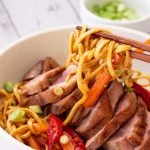
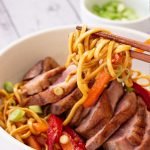
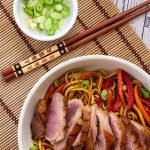
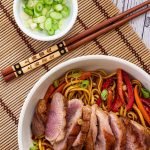
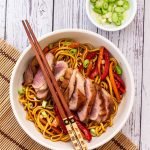
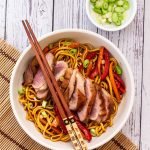
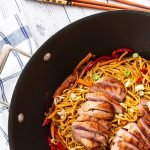
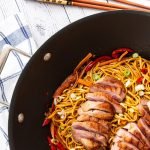


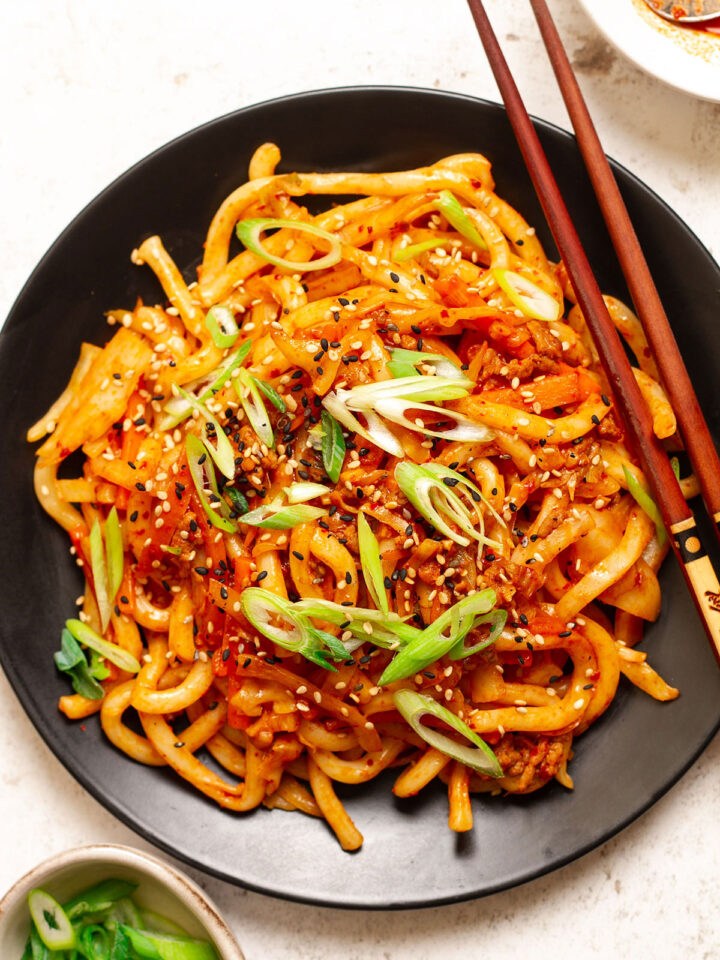
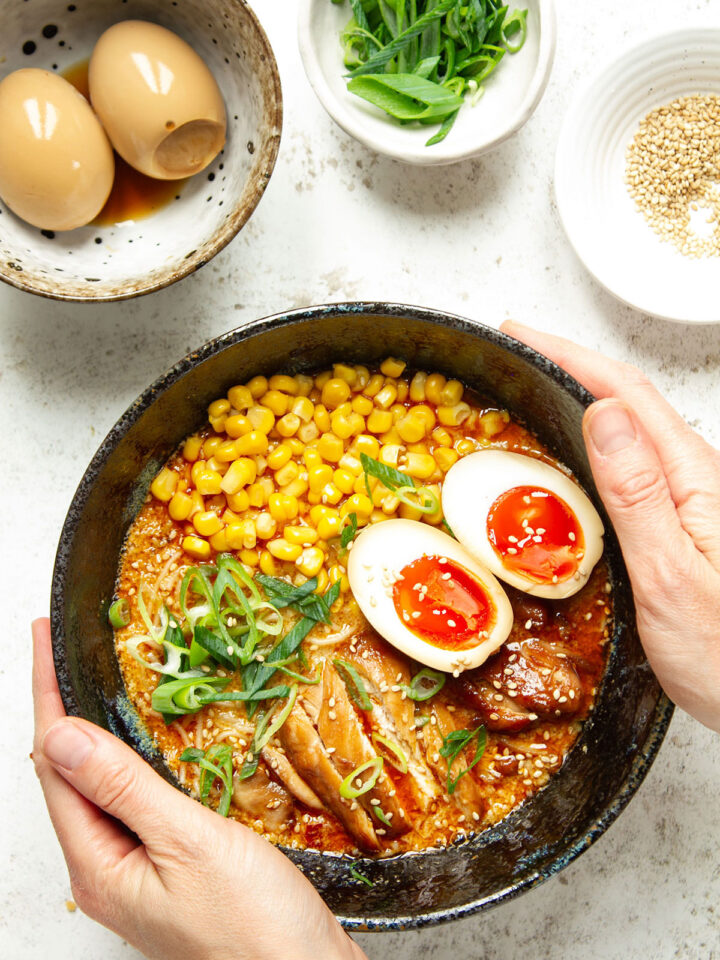
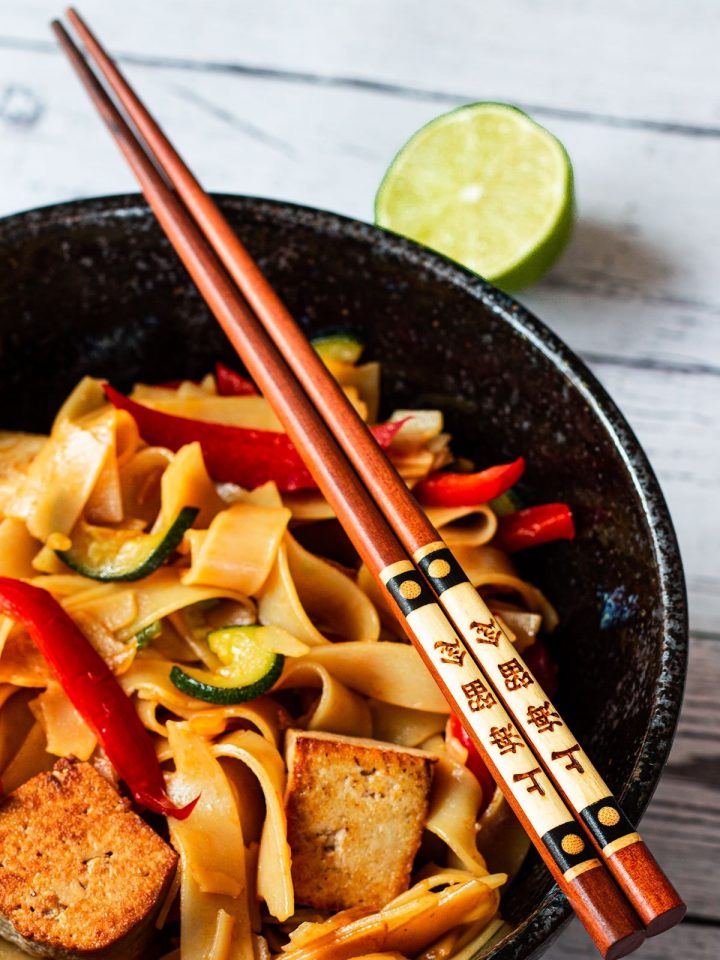
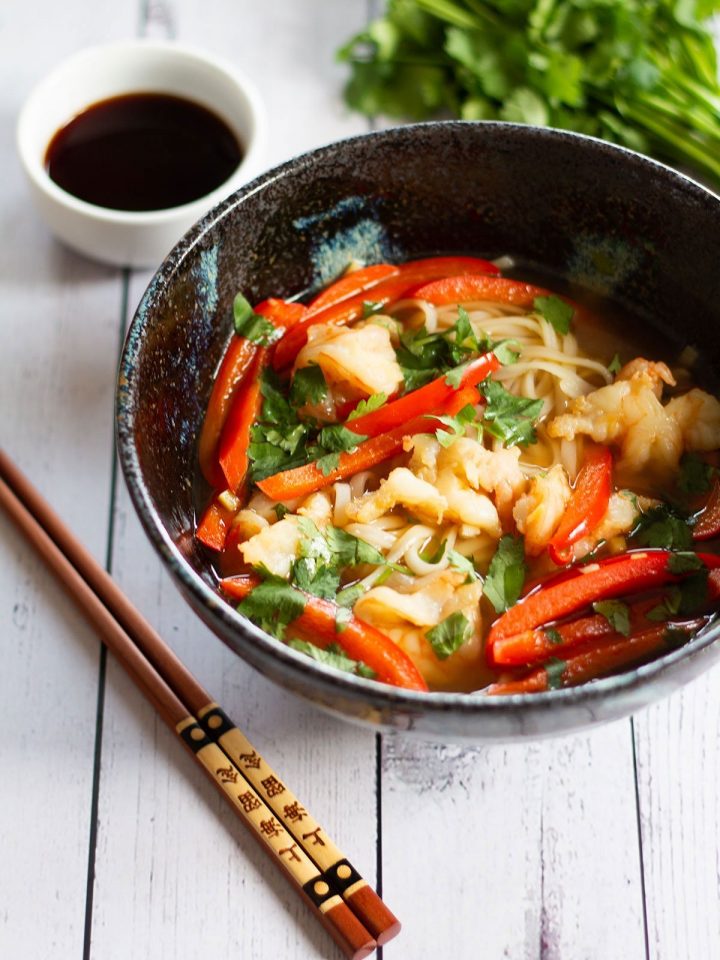
Made this for Valentine's Day this year and we both loved it, even if I did forget to add the ginger! The duck tasted amazing, and the noodles were as good as any we've ever had eating out.
Hi Calum, I'm really happy to hear that. Thank you for letting me know.
Surprised this didn't get any comments yet! This was the most interesting recipe for hoisin stir-fry duck I found and I just finished a plate as I write this comment. 10/10! The dish tastes really good, the flavors remind me the best Asian restaurants I tried in my life. Just a note, between step 9 and 10 there's some discrepancy in terms of the heat: 9 reduces to medium, then 10 is high again all of the sudden. Also, your garlic is "crushed", but photo shows chopped one and that's what I did, too — somehow I can't imagine this dish with coarse garlic bits.
Thank you for commenting Dawid. I'm so happy to hear you enjoyed it. I advise reducing the heat to medium in step 9 because garlic can burn when cooked at a high heat and suggest turning up the heat when adding the noodles to heat them quickly and get the pan nice and hot for the sauce. Once the noodles are in the garlic shouldn't burn as it won't have as much contact with the base of the pan. The garlic in my photo is crushed and not chopped, but perhaps my garlic crusher gives a coarser consistency than yours.